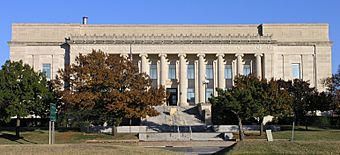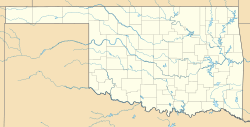Oklahoma Judicial Center facts for kids
Quick facts for kids |
|
|
Oklahoma Historical Society Building
|
|

Oklahoma Historical Society Building in 2006
|
|
| Location | 2100 N. Lincoln Blvd. Oklahoma City, Oklahoma |
|---|---|
| Area | 3.4 acres (1.4 ha) |
| Built | 1929-1930 |
| Built by | Holmboe Construction Co. |
| Architect | Layton, Hicks & Forsyth |
| Architectural style | Classical Revival |
| NRHP reference No. | 90000124 |
| Added to NRHP | February 21, 1990 |
The Oklahoma Judicial Center is where the highest courts in Oklahoma meet. These include the Oklahoma Supreme Court and the Oklahoma Court of Criminal Appeals. It is also the main office for the entire judicial branch of the state government.
This important building is located near the Oklahoma State Capitol. It was designed by the famous architectural firm Layton, Hicks & Forsyth. Construction happened between 1929 and 1930. The building was first home to the Oklahoma Historical Society. In 1990, it was added to the National Register of Historic Places as the Oklahoma Historical Society Building. The Historical Society moved to a new building in 2005. An extra part, called an annex, was finished in 2011.
What is the Oklahoma Judicial Center?
The Oklahoma Judicial Center is made up of two main parts. The first part is the old Oklahoma Historical Society Building. This building is also known as the Wiley Post Historical Building. It is about 68,156 square feet in size.
The second part is a newer building called the annex. It is about 77,362 square feet. Together, both buildings have a total of 145,518 square feet of space. The Judicial Center sits on a 3.4-acre piece of land. It is located near the Oklahoma State Capitol building.
What Does the Outside Look Like?
The original Historical Society Building has three floors and a full basement. Its outside walls are made of light-colored Indiana limestone. The base and steps are made of dark Georgia granite. The building's style is Classical Revival. This means it looks like ancient Greek and Roman buildings.
The building stands six feet higher than the street in front. Ten tall, round columns stand along the front. These columns have special tops called Ionic capitals. They hold up a decorative band called an entablature. This band has "Oklahoma Historical Society" written on it. It also has wreaths, which are symbols often seen on school buildings.
Main Entrance Details
Behind the columns is a shallow porch with a beamed ceiling. A low stone railing connects the columns. Two bronze doors are at the center of the entrance. They have a fancy iron screen above them. This screen lets light into the building.
Next to the doors are stone panels with carvings. They also have decorations like those on the front. Flowers and leaf designs decorate these panels. The granite steps go down in two wide sections. Each side of the lower steps has large, curled shapes.
Side and Back Views
Sections of the building stick out from the north and south ends. The windows on the first and second floors are made of steel. They are placed between flat stone columns. On the front, the first-floor windows have a detailed design above them. The second-floor windows have a scrolling leaf design. Windows on the sides are plain.
A decorative band of small blocks goes around the building. On the front, each side wing has smaller entrances. These look like simpler versions of the main entrance. They have windows with iron screens. Lights next to these entrances match the screens. The building's cornerstone is on the northwest corner. The back of the building has larger windows.
What Does the Inside Look Like?
A main feature inside is the marble staircase. It has a detailed iron railing. The walls inside are made of plaster with fancy decorations. The floors are made of marble, oak, and walnut wood. The hallways on each floor have plaster columns with decorated tops. They also have decorative bands.
Hallways and Stairs
These long hallways have patterned marble floors with borders. Marble also covers the lower part of the walls. The marble stairs have marble panels on all levels. The iron railing of the stairs has a scrolling leaf design. A walnut handrail is on top. This leaf design wraps around a marble post at each level. Even though the building is Classical, the lights are in the Art Deco style. Light courts, which are open areas, bring light into the upper floors. They also light up the old library room on the first floor.
Basement and Auditorium
The basement has ceilings with beams and square panels. These panels have small blocks and a repeated flower pattern. This level also has fancy decorations, marble floors, and oak doors. These doors have oval glass and screens made of leaded glass.
The basement also has a 400-seat auditorium. This is a large room for performances. It has a stage decorated with fabric swags. The walls have classical designs. Large Art Deco chandeliers hang from the ceiling.
Main Entrance and Reception
Inside the bronze main entrance doors, there is another set of wooden doors. These have brass trim and a stained-glass Art Deco screen above them. Between these two sets of doors is a small entry area. It has floors made of Tennessee and Tavernelle marble. This area also has a decorative band with a scrolling leaf design.
On the first floor, past the entry area, is a reception space. It has an arched, vaulted ceiling. The hallway on the first floor has columns and a decorative band with a wave pattern.
Upper Floors
The second-floor hallway has beamed ceilings. Its columns have flat Corinthian tops. This floor has the most detailed decorative band. It shows plaster garlands with ribbons, leaves, and flowers. This hallway also has egg and dart molding and small blocks. It has a second Art Deco design too.
The third-floor hallway has a plain beamed ceiling. Its columns have Corinthian tops, like those on the second floor. A special part of the third floor is the wall paintings. These show eight Native American figures. They were painted by Kiowa artists Monroe Tsatoke and Spencer Asah. Their work was paid for in the 1930s by a government program. These artists were part of a group called the Kiowa Six. They painted art for many state and federal buildings in Oklahoma. The third floor was first built to be an art gallery. Its ceilings were curved to meet the walls and had skylights. A small metal staircase on the south end leads to mechanical areas.
What is Around the Building?
The front lawn of the building has a copy of the Liberty Bell. It also has an old cannon and a piece of a building that was torn down. To the north of the main building is the Oklahoma American Legion War Memorial. This memorial has an eternal flame. It also has four statues honoring soldiers from World War I, World War II, the Korean War, and the Vietnam War.
History of the Judicial Center
The Oklahoma Historical Society used to be in the Capitol building since 1917. But it needed more space as it grew. Other state offices also needed more room. Robert L. Williams, a judge and former governor, helped create a law. This law would pay for a new building for the society.
Governor William J. Holloway approved the law on March 1, 1929. Construction began before the end of that year. The law set aside $500,000 for the building. This money came from selling school lands. Williams became the head of the committee that chose the architects and builders. After visiting many cities, the committee chose the Minnesota Historical Society Building as a model.
Building Design and Construction
Architect Solomon Andrew Layton traveled with the committee. His firm, Layton, Hicks & Forsyth, designed the building. They also designed other important buildings, including the nearby Capitol. Holmboe Construction Co. built the structure. Edward P. Boyd oversaw the work. The building was finished in 1930.
Decorative lights were added around 1960 at the top of the front steps. In the past, there were also exhibits on the property. These included an oil well and other oil industry items. They were put there around 1960. A shop for exhibits was added in 1982. The war memorial was dedicated on November 11, 1969. The memorial itself was built in 1986. The building's auditorium was repaired in 1982-1983.
Becoming a Historic Site
The Oklahoma Historical Society Building was added to the National Register of Historic Places on February 21, 1990. This means it is recognized as an important historic site. The building itself was listed as a key part of this history. The old exhibit shed and oil well were not included. The listing noted the building's long role in preserving state history. It also recognized it as a great example of Layton, Hicks & Forsyth's architectural work.
The Oklahoma Historical Society moved to the Oklahoma History Center in 2005. In 2011, the original building was restored. A new annex was also built. This project cost $35 million. After this work, the building reopened as the Oklahoma Judicial Center.



